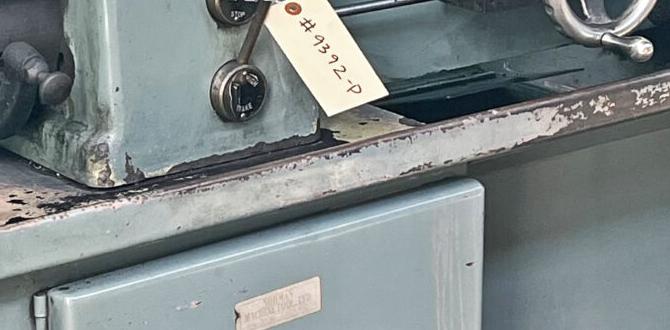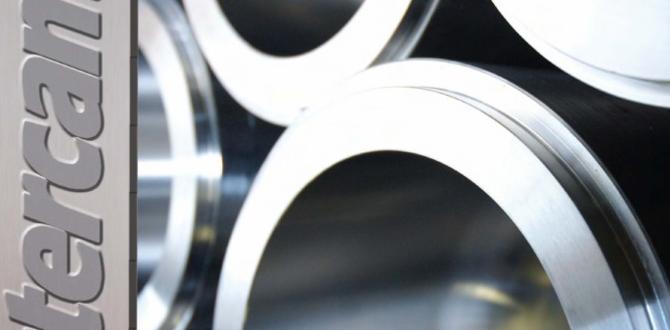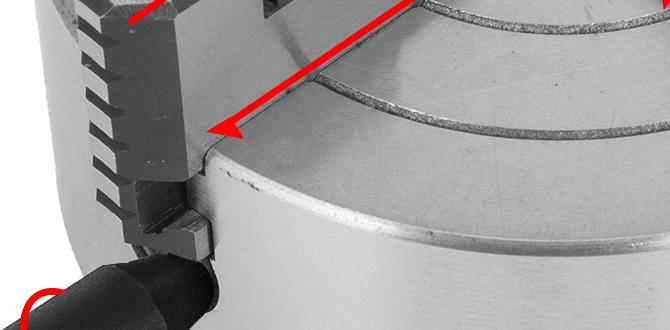Hitting that annoying ringing sound – chatter – when milling acrylic can be incredibly frustrating. It leaves fuzzy, ugly marks on your workpiece, ruining otherwise good projects. You’ve probably tried adjusting speeds and feeds, but that persistent vibration keeps coming back. Don’t worry, many beginners face this. The good news is, there’s a simple, proven solution: using the right carbide end mill. This guide will show you exactly why and how it works, so you can get those perfectly smooth acrylic cuts you’re aiming for.
Understanding Acrylic Chatter: The “Ringing” Problem
Acrylic, while a fantastic material for makers and machinists, can be a bit tricky to cut. It’s a thermoplastic, meaning it softens significantly when heated. When your end mill cuts into it, friction generates heat. If the cutting conditions aren’t just right, this heat and the material’s properties can cause the tool to “grab” and release repeatedly. This rapid, uneven engagement and disengagement is what we call chatter, and it’s what creates that high-pitched ringing sound and the undesirable surface finish.
Chatter is essentially a vibration issue. It happens when the cutting forces and the machine’s natural frequencies align. Think of it like strumming a guitar string – if you hit it with just the right force and at the right time, it vibrates. In milling, chatter occurs when the tool isn’t cutting smoothly and consistently. This can be due to several factors:
- Tool Geometry: The shape and angle of the cutting edges.
- Cutting Speed & Feed Rate: How fast the tool spins and how quickly it moves through the material.
- Machine Rigidity: How much the machine itself vibrates.
- Tool Holder Issues: A loose or unbalanced tool holder.
- Material Properties: How dense and brittle the acrylic is.
For beginners, trying to solve chatter often involves a lot of trial and error with speeds and feeds, which can be confusing. Fortunately, the tool itself plays a massive role, and choosing the right one can make all the difference. One of the most effective solutions is using a specialized carbide end mill designed to cut acrylic cleanly.
Why Carbide End Mills are Your Acrylic’s Best Friend
When it comes to milling plastics like acrylic, not all end mills are created equal. While standard HSS (High-Speed Steel) end mills might work for some materials, they often struggle with plastics. This is where carbide and specific flute geometries come into play.
The Magic of Carbide
Carbide, or Tungsten Carbide, is an incredibly hard and wear-resistant material. It’s much harder than HSS. This hardness is crucial for a few reasons:
- Keeps an Edge: Carbide stays sharp for much longer, meaning consistent cutting performance. A dull tool is a primary cause of chatter.
- Heat Resistance: While friction still creates heat, carbide handles it better than HSS. This helps prevent the acrylic from melting back onto the cutting edge, which can cause buildup and inconsistent cutting.
- Rigidity: Carbide is stiffer than HSS, meaning less deflection under cutting forces. This contributes to a more stable cut.
For acrylic, the standard “single flute” or “O-flute” carbide end mill is often the go-to choice. Why? Let’s break it down.
Single and Two-Flute “O-Flute” End Mills for Acrylic
While traditional milling often uses end mills with multiple flutes (2, 3, or 4), acrylic milling often benefits from fewer flutes. The term “O-flute” or “zero flute” is a bit of a misnomer; these end mills typically have one or two highly polished, sharp flutes designed for plastics.
- Efficient Chip Evacuation: Acrylic, when it melts and recuts, can create gummy chips. A single, large flute with a highly polished surface and a generous chip gullet (the space between flutes) allows these gummy chips to escape easily. This prevents chip recutting, which is a major contributor to heat and chatter.
- Reduced Heat Buildup: With fewer flutes engaging the material at any given moment, there’s less friction and less heat generated. This is vital for thermoplastics like acrylic, which can easily melt.
- Lower Cutting Forces: Fewer flutes mean less material being removed simultaneously. This reduces the overall cutting forces, leading to a more stable cut and less tendency for vibration.
- Polished Surfaces: Many O-flute end mills designed for plastics have highly polished flute faces. This smoothness reduces friction and prevents the molten plastic from sticking to the tool, further aiding chip evacuation.
In essence, these specialized end mills are designed to cut acrylic like a hot knife through butter, rather than grabbing and tearing it. This directly combats the root causes of chatter.
Choosing the Right Carbide End Mill: Key Features
When you’re looking for that perfect acrylic-cutting end mill, here are the key features to keep an eye out for. This will help you specifically find a tool like a “carbide end mill 1/8 inch 10mm shank extra long for acrylic reduce chatter.”
Material & Coating
- Carbide: As discussed, high-quality solid carbide is non-negotiable for consistent results.
- Coating: While not strictly necessary for acrylic, some coatings like TiCN or AlTiN can offer additional heat and wear resistance, though they are often overkill for softer plastics. For acrylic, a polished, uncoated carbide is usually ideal to prevent material buildup.
Flute Count
- Single Flute (O-Flute): The champion for most acrylic milling. It offers the best chip evacuation and minimizes heat buildup.
- Two Flute (High-Performance Plastic): Some specialized two-flute end mills with very high helix angles and polished flutes can also work well, especially for slightly faster cutting. However, single flute is generally safer for beginners.
Helix Angle
The helix angle refers to the steepness of the flutes. For plastics, you generally want:
- Low to Moderate Helix Angle (around 20-30 degrees): This provides good chip thickness and effective chip evacuation without being too aggressive.
- High Helix Angle (45 degrees or more): Sometimes used for very aggressive plastic machining, but can generate more heat.
For acrylic, a moderate helix angle on a single flute tool is usually perfect.
Shank Diameter vs. Cutting Diameter
This is where your specific requirement (“1/8 inch 10mm shank”) comes in. You’ll often see tools specified like this:
- Cutting Diameter: The diameter of the part that actually does the cutting.
- Shank Diameter: The diameter of the tool shaft that goes into your collet or tool holder.
A common setup will be an end mill with a 1/8 inch cutting diameter and a 1/8 inch shank. However, you might also see tools with a smaller cutting diameter and a larger shank (like a 1/8 inch cutting diameter on a 1/4 inch shank) for added rigidity. The “10mm shank” specification is interesting and might be for machines designed for metric tooling. For an “extra long” tool, this usually refers to the flute length or overall length, allowing for deeper cuts or reach.
Flute Length (Up-cut vs. Down-cut vs. Straight)
This is also important for cutting acrylic:
- Up-cut: The flutes spiral upwards. These are the most common and are excellent for chip evacuation up and out of the cut. This is generally the best choice for acrylic.
- Down-cut: The flutes spiral downwards. These push chips down and can create a smoother top surface finish but are poor for chip evacuation and can cause acrylic to melt onto the tool. Avoid these for acrylic generally.
- Straight Flutes: Rare for end milling, more common for reamers.
For acrylic, you almost always want an up-cut single flute carbide end mill. The “extra long” aspect usually refers to the flute length, allowing for more depth of cut or reaching into deeper pockets.
Example Keyword Breakdown: “carbide end mill 1/8 inch 10mm shank extra long for acrylic reduce chatter”
Let’s decode this to find the perfect tool:
- “carbide end mill”: Specifies the material – essential.
- “1/8 inch”: Likely refers to the cutting diameter. This is a common small size for detailed work.
- “10mm shank”: This indicates the tool holder interface. It means the part of the tool that grips into the collet is 10mm in diameter. This is a metric size.
- “extra long”: This can refer to flute length or overall tool length, allowing for deeper cuts or reaching into workpieces.
- “for acrylic”: Specifies the intended material.
- “reduce chatter”: Highlights the primary benefit you’re seeking.
So, you’d be looking for a single-flute, up-cut, carbide end mill with a 1/8-inch cutting diameter, a 10mm shank, designed for plastics/acrylic. The “extra long” feature is good to note but ensure it doesn’t compromise rigidity for your specific job.
Step-by-Step: Milling Acrylic Smoothly with Your New End Mill
Now that you’ve chosen the right tool, let’s get to cutting! Follow these steps to achieve chatter-free acrylic milling.
Step 1: Secure Your Workpiece
This is paramount for safety and precision. Acrylic can slip if not clamped properly. Use clamps that don’t overtighten and potentially crack the acrylic. For thin sheets, consider using a spoilboard or doubling it up with a sacrificial layer underneath.
Pro Tip: If you can, use a vacuum table or double-sided tape designed for CNC work for extra security on larger, thinner pieces.
Step 2: Install the Correct End Mill
Ensure your collet is clean and matches the shank diameter of your end mill (in this case, 10mm). Insert the end mill firmly into the collet and tighten it securely. A loose tool is a recipe for disaster and will definitely cause chatter.
Step 3: Determine Your Speeds and Feeds
This is where the magic happens, and it’s often simpler than you think for acrylic with the right tool. The goal is to cut cleanly without melting or vibrating.
Here are some starting points for a 1/8 inch single-flute O-flute carbide end mill:
- Spindle Speed (RPM): Start around 18,000 – 24,000 RPM. Higher speeds can sometimes help “outrun” chatter, but too high can melt the acrylic.
- Feed Rate (IPM or mm/min): This is crucial. You want to remove material efficiently but not aggressively. Start between 20-40 inches per minute (500-1000 mm/min).
- Plunge Rate: Plunge slowly to avoid digging in. Start at 10 IPM (250 mm/min).
- Depth of Cut (DOC): For a 1/8 inch end mill, don’t take too much off in one pass. Start with a shallow depth, perhaps 0.06 to 0.1 inches (1.5 to 2.5 mm). You can take multiple passes to reach your final depth.
Important: These are starting points. Always perform a test cut on a scrap piece of the same acrylic. Listen to the sound. A nice, crisp “shhhhk” sound is good. A high-pitched squeal or ringing is chatter.
Step 4: Set Your Zero and Perform a Test Cut
Carefully set your X, Y, and Z zeros. It’s advisable to do a “dry run” (without cutting) to ensure your toolpaths are correct and the machine moves as expected. Then, run your test cut on the scrap piece and gradually adjust feed rates and/or spindle speed if you hear any hint of chatter. If you hear chatter, try increasing the feed rate slightly, or reducing the depth of cut. Sometimes, even a small increase in feed rate can eliminate it.
Step 5: The Cut!
Once you’re happy with your test cut, run your actual project file. Watch and listen. The clear, crisp sound of the end mill slicing through acrylic should be evident. If you encounter chatter suddenly, stop the machine, check your tool, your clamping, and your speeds/feeds. Often, a small adjustment is all that’s needed.
Troubleshooting & Fine-Tuning
Even with the right tool, sometimes you might still encounter issues. Here’s how to tweak things:
If Chatter Persists:
- Increase Feed Rate: This is often the first and easiest adjustment. Faster movement can mean the tool spends less time in any one spot, reducing hammering.
- Decrease Depth of Cut: Taking thinner “slices” reduces the load on the tool and the machine, minimizing vibrations.
- Check Spindle Speed: While higher is often better, too high can melt. If you’re already at the upper end of the typical range, consider if a slightly lower RPM (e.g., 15,000) with a more conservative feed rate might be more stable, though this is less common for chatter.
- Ensure Tool and Holder are Clean: Even a tiny bit of plastic residue can throw off your cut.
- Machine Rigidity: If your entire machine shakes, it’s hard to eliminate chatter entirely. Ensure your CNC is on a very stable base. Ensure no loose screws or belts.
- Consider Climb Milling: For acrylic, climb milling (where the cutter rotates in the same direction it’s moving into the material) is generally preferred for a smoother finish and reduced chatter.
For Melting or Gummy Chips:
- Increase Feed Rate: You’re likely feeding too slowly, allowing the tool to dwell and melt the material.
- Increase Spindle Speed: A faster spin means less dwell time in one spot.
- Ensure Good Chip Evacuation: Make sure your O-flute tool is clean and that your CAM software isn’t creating too many small, overlapping passes that clog the flutes.
For Edge Breakout (Slight Chipping on the Exit):
Plastic can sometimes chip right as the tool exits the material. This is less about chatter and more about the material failing under tension.
- Use a Tab: In your CAM software, leave small “tabs” of material uncut to hold the piece firmly until the very end.
- Support the Back: Ensure the acrylic is fully supported below where the tool is exiting.
- Bottom Cut First (if applicable): If pocketing, try to do the bottom of the pocket before profiling the outside.
Tools and Accessories for Success
Beyond the carbide end mill, a few other items can greatly improve your acrylic milling experience:
- Collets: Ensure you have high-quality, accurately sized collets. For your 10mm shank tool, a 10mm collet is essential.
- CNC Machine: A rigid and well-maintained machine is key.
- CAM Software: Software like Fusion 360, Carbide Create, VCarve, or others will allow you to generate toolpaths. Ensure you can set parameters for feed rates, speeds, depth of cut, and tabs. Many CAM packages have specific profiles for plastics.
- Dust Collection: While acrylic dust isn’t as hazardous as some metals, and plastic chips are often larger, good dust collection is always recommended for any workshop.
- Safety Glasses: Absolutely essential. Always wear eye protection when operating machinery.
- Deburring Tool: A deburring tool or even a smooth file can be handy for cleaning up any minor edges after cutting.
Why Not Use a Standard Multi-Flute End Mill?
You might be wondering why you can’t just use a standard 2-flute or 4-flute HSS or carbide end mill. While they can cut acrylic, they are much more prone to chatter and melting for beginners because:
- Chip Packing: More flutes mean less space for chips. For gummy materials like acrylic, this leads to chips getting packed into the flutes, increasing friction, heat, and tool pressure – a perfect storm for chatter.
- Heat Buildup: With more edges engaging the material simultaneously, more heat is generated.
Specialized O-flute end mills are designed to combat these issues directly, making them the superior choice for clean, chatter-free acrylic cuts, especially for those






